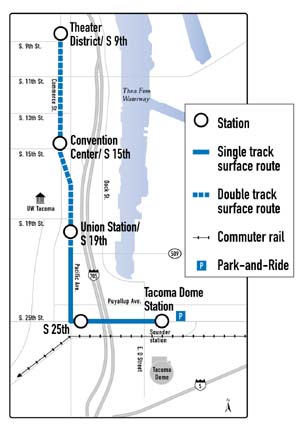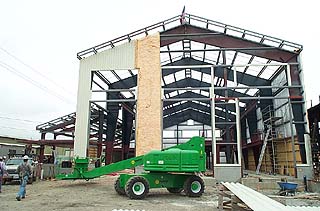|
Subscribe / Renew |
|
|
Contact Us |
|
| ► Subscribe to our Free Weekly Newsletter | |
| home | Welcome, sign in or click here to subscribe. | login |
Construction
| |
 |
September 20, 2001
Sound Transit seeks success in Tacoma
Special to the Journal

Image courtesy of Sound Transit A map of Tacoma’s 1.6-mile-long Link light-rail train shows five stations serving some of the city’s major attractions, from the theater district to the site of the planned Tacoma Convention Center. |
Tacoma’s $22.5 million, 1.6-mile-long light-rail project — already under construction — may be Sound Transit’s first big success story in its multibillion-dollar campaign to ease Puget Sound’s serious traffic congestion.
Practically speaking, the city’s short Link service between the Tacoma Dome and the downtown core will have little immediate impact on Pierce County’s often-clogged stretches of Interstate 5. But the project has a significance that makes it a key part of Sound Transit’s master plan for several reasons.
First, the Tacoma line will be the first completed segment of Sound Transit’s light-rail plan, so it will have an emotional and psychological benefit for both the transit agency and the city of Tacoma.
Second, the rail line will make it easier for commuters, students and tourists to travel in and out of Tacoma’s rapidly expanding downtown core.
Third, the Link project will eventually connect to a tri-county light-rail system that Sound Transit officials expect will play a major role in reducing Puget Sound traffic congestion.
Linking attractions
By the spring of 2003, the first passengers on Tacoma’s Link light-rail line should be on board, traveling between the Tacoma Dome at I-5 and the city’s downtown core 10 to 14 hours a day, seven days a week. Although it’s a short route, the importance of the project to the city of Tacoma is enhanced by the major attractions that will be served by the line’s five stations. For example:
- The Tacoma Dome is already a multimodal facility, home to a major commuter bus park-and-ride lot. Coming in the next few years will be commuter rail, the Link light-rail line, express bus service, local and interstate buses and Amtrak passenger trains. A Pierce Transit and Sound Transit parking garage opened there last fall, adding 1,200 parking stalls.
- A new public plaza will be created between the Dome, which hosts major entertainment and music events, and the Freighthouse Square market center. There are also plans underway for the multimillion dollar Harold E. LeMay Museum, opening in 2005. It’s expected to attract more than 350,000 visitors from around the world each year to see a portion of the Tacoma resident’s 2,400-vehicle collection of vintage autos, the world’s largest private collection.
-
Adjacent to the UW-Tacoma campus, which is in the midst of a $36.4 million expansion, will be a new $88 million waterfront development with shops, restaurants, condominiums and a hotel, all part of the Thea Foss Esplanade to be completed in 2002. The project includes the International Glass Museum and the Chihuly Bridge of Glass.
- In 2002, the Pioneer Motorcycle Museum will open at the entrance to the Thea Foss Waterway, a privately funded museum displaying vintage motorcycles and memorabilia dating back to 1908.
- The new $25 million Tacoma Art Museum, due to open in 2003, will be adjacent to the Union Station.
- Construction is expected to begin soon on a 236,000-square-foot, $120 million, five-story Tacoma Convention Center between the University of Washington campus and the downtown business district. Due to open in late 2003 or early 2004, the center will also include an adjacent, 175-room hotel to be built by Hollander Investments of Bellingham.
- Tacoma’s popular theater district of restored entertainment venues, plus financial and shopping attractions in the downtown core, are at the other end of the Link route.
All of those projects, and other commercial developments, are within the 1.6-mile reach of the Link trains. Also, there will be new streetscapes, including sidewalks, trees, benches, bike racks, community kiosks and related development along the route, added amenities that Tacoma officials hope will stimulate new development in neighborhoods along the way.
Jobs and tourism

Photo courtesy of Sound Transit Work is under way on a $4 million operations and maintenance center for Tacoma’s light-rail trains at the Tacoma Dome, near Freighthouse Square. The contractor is Berschauer Phillips of Olympia. |
Kevin Phelps — who is deputy mayor of Tacoma, a member of the Sound Transit board, chair of the Tacoma-Pierce County Visitors Bureau and owner of the Landmark Convention Center in downtown Tacoma — sees the Link project as “ultimately the best way to connect (Tacoma) to the entire Puget Sound area a number of years down the road.”
For now, he’s happy to have the Tacoma project under way.
“The Tacoma Dome is the only true intermodal facility in the state. It’s important when you look at moving people from the South Sound into Seattle. But we also see the (completed Sound Transit network) as a way of bringing jobs south to Tacoma from Seattle, Kent, and Auburn, as well as north from Puyallup without using cars,” Phelps said. “And we see the downtown Link route as a way of creating more workforce downtown without cars as well as serving students and faculty at the University of Washington’s Tacoma campus.”
Phelps said tourism is also a major goal for the short light-rail line.
“The developments downtown have the potential for attracting more than a million tourists and local visitors a year into the theater district, the museums and the art and convention centers,” he said.
“If you look at light rail as an individual project and look at the ridership it looks like we’re spending a lot of money for Link. But in the context of the bigger picture, the day will come, we all know, when it will connect with commuter rail, buses and other transportation for the whole region.”
There’s also a positive psychological aspect to the Link project in Tacoma.
“We’re going to build this on time and on budget. This is a chance to start regaining the confidence of the public. I think it will be healthy for Seattle to see ground-level light rail up and running,” Phelps said. “I’m familiar with Portland’s ground-level light rail and I think Tacoma’s will add to building more support for Sound Transit’s programs.”
Downtown renaissance
Phelps said he is excited about projects such as the new Tacoma Convention Center and the positive impact that both the center and Link will have on each other.
“I will compete with this new center with my own business but I support it because I think it is the right think for our community. It will have an impact on my business but it will also have a long, positive impact for our region,” he said.
“The presence of both public and private development within the convention center project provides an opportunity to build an exciting and strong downtown urban core,” said Juli Wilkerson, Tacoma’s Economic Development Department director. “The convention center will be a magnet for public activity.”
Sound Transit spokesperson Lee Somerstein said the Freighthouse Square/Tacoma Dome Sounder station will be make a tremendous difference in that neighborhood.
“We think Link will be part of the renaissance going on in downtown Tacoma. The project will also bring public art, new streetscapes and architectural enhancements to the city,” Somerstein said.
Preliminary work
The Gary Merlino Construction Co. of Seattle, Sound Transit’s primary contractor for the Link project, has already begun preliminary work on the light-rail route. Unlike Seattle, the Tacoma project uses only local funds and is unaffected by the federal funding delay experienced by the Central Link project in King County.
| What it will look like |
|
The trains By the spring of 2003 Tacoma's electric-powered, state-of-the-art trains -- with low floors for easy access, including wheelchair passengers -- will be traveling 10 to 14 hours each day, running on steel tracks built into the street between the Tacoma Dome Station and downtown Tacoma. Sound Transit is paying $9 million for three of the three-section articulated vehicles, 60-foot-long cars seating 30 people with room for 26 standing passengers. The trains already ordered and under construction in the Czech Republic. Rides will be free. Although the trains will not exceed posted vehicle speed limits on the route, they will have priority over traffic signals so it will take only eight minutes to complete the 1.6-mile stretch, traveling less than two minutes between stops. The stations There are five stations: at the Tacoma Dome; at South 25th Street where the line turns onto Pacific Avenue; at Union Station and the Federal Courthouse at South 19th Street; at the Tacoma Convention Center at South 15th Street; and at the theater district on South Ninth Street. Each station will have recognizable elements, but each will also be uniquely designed to reflect the character of their neighborhoods. For instance, the station in the theater district will have stage lighting along the roof trusses and theater-style seats for riders rather than benches. The attractions The Link light-rail service is expected to attract tourists as well as commuters. Along the route will be the Tacoma Dome with its entertainment events; a new public plaza to be built between the Dome station and the Freighthouse Square market building; the planned LeMay museum, which will house the world’s largest private car collection; the Washington State History Museum; access to the new International Glass Museum, the Chihuly Bridge of Glass and other waterfront attractions now under construction; and a new regional convention center with a 400-room hotel. |
Presently, the only delay in the Tacoma project is waiting for approval by the Federal Railroad Administration, and an agreement with Burlington Northern Sante Fe Railroad, for Link’s Pacific Avenue crossing of the BNSF tracks.
A closed Chevron station on the route has been cleared at the northwest corner of South 17th Street and Pacific Avenue and removal of underground tanks and contaminated soil will follow. The work is being performed by Emerald Services of Seattle.
Also, work is under way on a $4 million operations and maintenance facility and training base for the light-rail trains. Once existing industrial buildings are cleared by RH Rhine Inc. of Tacoma, contractor Berschauer Phillips of Olympia will build an 11,000-square-foot metal building on the site.
Gary Merlino Construction Co. will also be moving ahead with relocating utilities along 25th Street between McKinley and Pacific Avenue, including placement of conduits and storm drains, sidewalk improvements and installing street-embedded rails.
Awards
Even though it hasn’t been built yet, the Tacoma light-rail project has been winning awards. Last October, the Washington Chapter of the American Planning Association and the Planning Association of Washington honored the city with its highest award for Tacoma’s Station Area Development Strategies Report, the blueprint that will govern future development along the Link rail line.
In 1998, with Sound Transit funding, the city hired Seattle’s LMN Architects to help Tacoma examine how the light-rail project would affect the city’s land use, transportation, housing, downtown design and overall economy.
“As the first city in Washington to get light rail, I am proud that our planning and forethought will establish a model other cities can follow,” said Wilkerson. “When we have a downtown that is well planned, organized and thriving, everyone wins.”
For more information, contact the city of Tacoma’s Web site at www.cityoftacoma.org or Sound Transit at www.soundtransit.org.
Terry Stephens is a freelance writer based in Arlington. He can be reached by e-mail at features@gte.net.
Other Stories:


